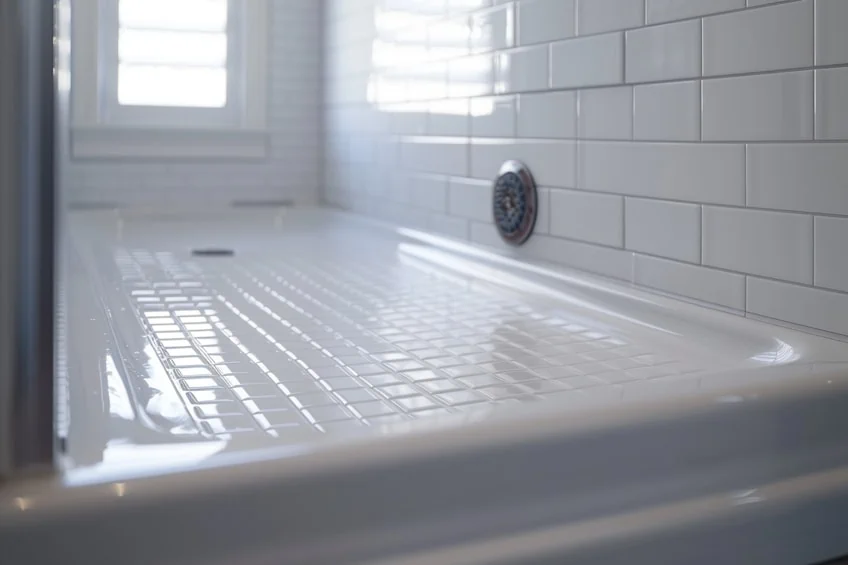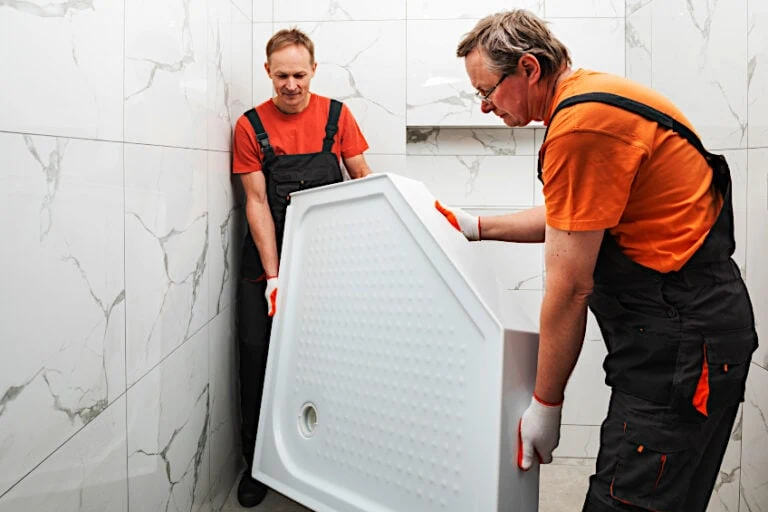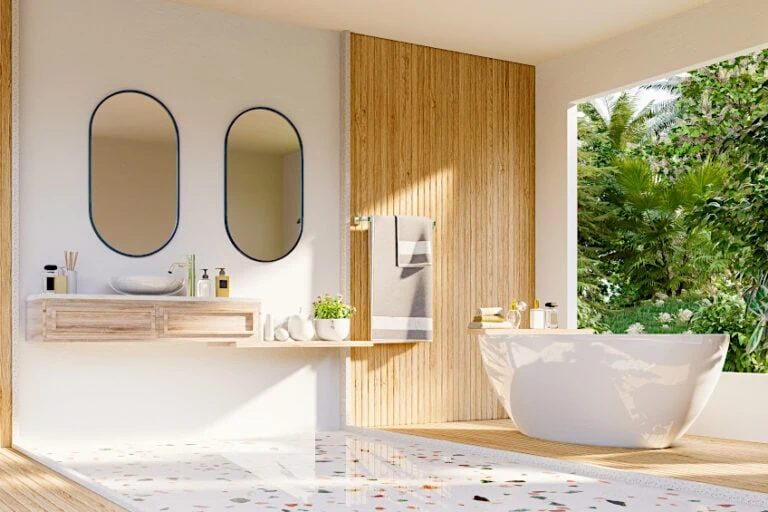Shower Pan Sizes – Sizing the Splash
This post may contain affiliate links. We may earn a small commission from purchases made through them, at no additional cost to you.
Welcome to the world of shower pan sizes, where bathing becomes a delightful dance of dimensions! Much like selecting the perfect pair of shoes, choosing the right shower pan size can truly elevate your bathroom experience. From cozy corner cubbies to sprawling spa-like retreats, the array of options is as vast as the sea itself. So, whether you’re aiming for a snug fit or a grand splash, let’s dive into the world of shower pan sizes and make a splash of our own!
Key Takeaways
- Shower pans are essential for directing water to the drain and avoiding leaks.
- There are standard sizes available, as well as custom options to fit unique spaces.
- The right shower pan must match the drain location and integrate seamlessly with surrounding elements.
What Is a Shower Pan?
A shower pan – often referred to as a shower base – is the foundation of a shower enclosure and a critical water-tight component that sits beneath the floor of the shower. Its purpose is to collect water and channel it to the drain. Without a reliable shower pan, water could leak and cause significant damage to the structure of a home. Shower pans are typically crafted from various materials such as acrylic, fiberglass, or composites, and they come in an array of sizes to accommodate different shower configurations.
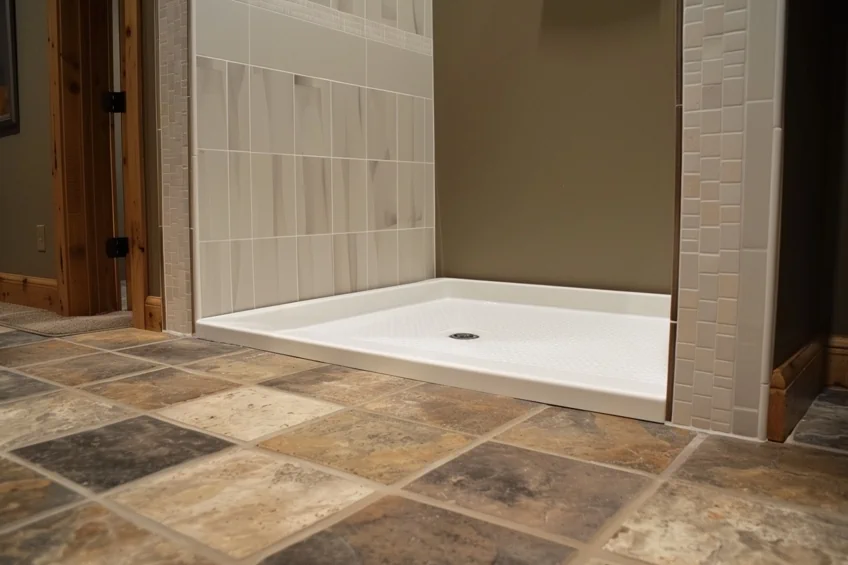
They are designed to be both durable and waterproof, providing a solid, flat surface that can support the weight of the user, as well as the walls and doors of the shower. These bases have either a square, rectangular, or neo-angle design, matching the shape of the enclosure it aims to support. The design and material of a shower pan also contribute to the overall aesthetic of the bathroom. It’s crucial that the shower pan is installed correctly to ensure it functions properly, directing water efficiently toward the drain.
Selecting the appropriate size is a vital step in preventing water damage and ensuring the longevity of the bathroom’s design and structure.
Understanding Shower Pan Basics
When considering a bathroom renovation or new shower installation, understanding the basics of shower pans is essential. They are the foundation of a shower, ensuring water is directed towards the drain and away from the surrounding area to prevent water damage.
Shower Pan Materials
Shower pans can be crafted from various materials, each offering distinct benefits. Acrylic shower pans are popular due to their durability and ease of cleaning. Fiberglass options provide a cost-effective and lightweight alternative. Composite materials are valued for their strength and modern aesthetic. For a more luxurious look, solid surface materials or natural stone can be used, while cast iron pans offer classic appeal with enduring robustness.
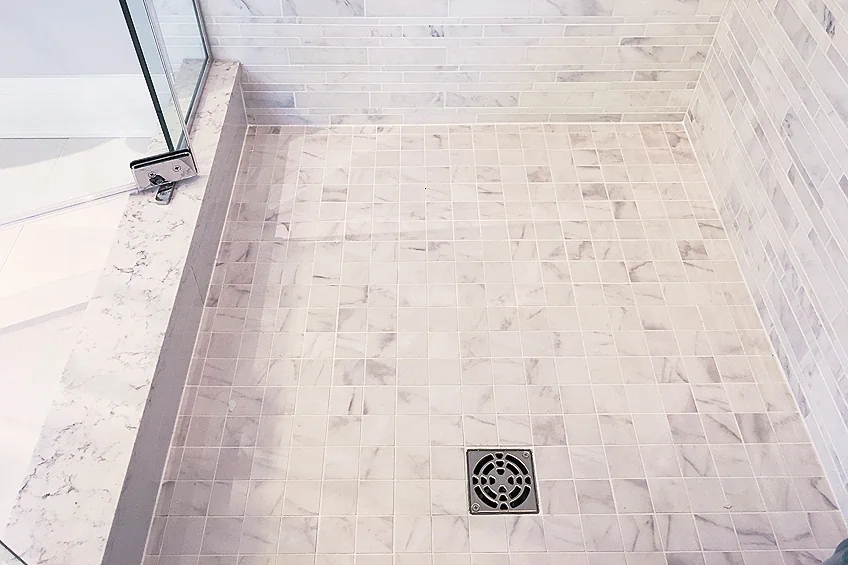
Standard Sizes
Standard shower pan sizes facilitate easier installation and compatibility with pre-built shower enclosures. The following list presents common dimensions:
- Square shower pans: Typically 32″ x 32″ or larger
- Rectangular shower pans: Often found in sizes such as 36″ x 48″
- Neo-angle shower pans: Designed for corner installations, ranging from 36″ to 60″ wide
Custom Options
For bathrooms that require non-standard sizes or specific design needs, custom shower pans are available. A custom shower pan allows for flexibility in dimensions and shape, accommodating unique bathroom layouts and sizes, from small to large shower pans. They can be tailored to suit precise measurements and are ideal for walk-in showers or specific bathtub replacement pan scenarios.
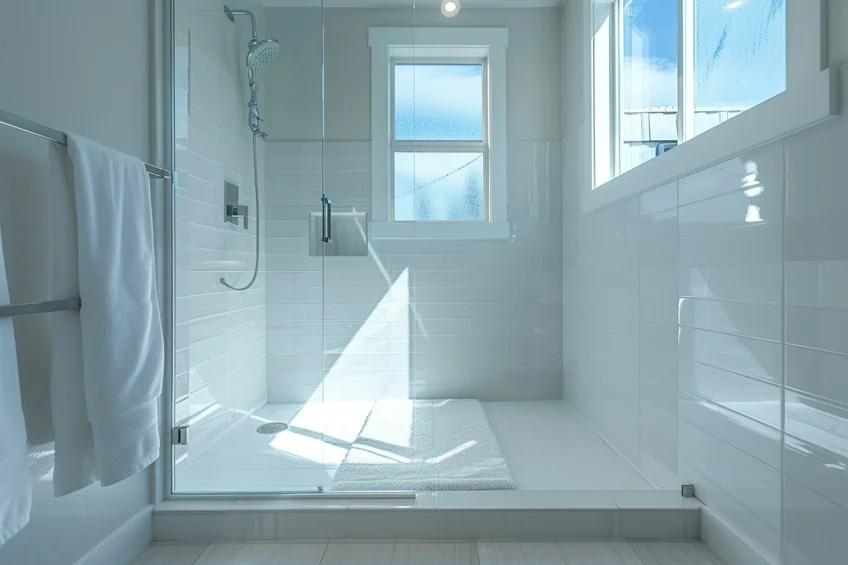
Design Considerations
Designing the ideal shower involves more than merely selecting a shower pan material and size. Consideration must be given to the bathroom’s overall layout and the intended use of the shower. Corner shower pans maximize space in small bathrooms, whereas neo-angle designs offer a contemporary look.
The choice between a small shower pan or a large one should be informed by user comfort, bathroom size, and any additional features such as built-in seating or accessibility requirements.
Installation and Waterproofing
Proper installation and waterproofing of a shower pan are critical to ensure functionality and prevent water damage. Without these steps, even the best-selected shower pan sizes may fail to protect the integrity of the bathroom structure.
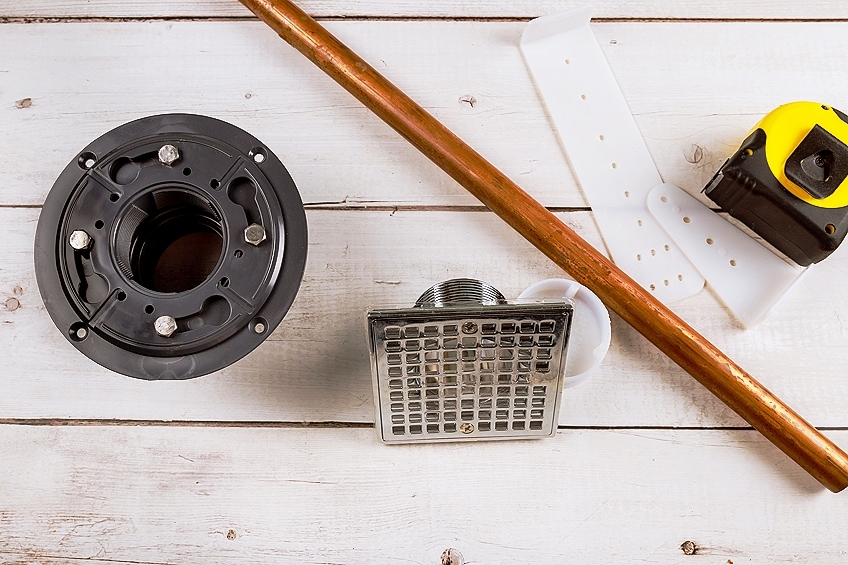
Shower Base Installation Process
When installing a shower base, the first step is measuring the area to determine the appropriate size for the shower pan, which commonly ranges from 30 by 30 inches to 48 by 60 inches for rectangular designs. Selection of a pan that fits the space and matches the drain location is essential.
For instance, a 32-inch x 32-inch pan is a good fit for smaller showers, while larger areas may accommodate a 42-inch x 60-inch pan.
Following the selection process, the next step is to prepare the subfloor, ensuring it is clean, level, and structurally sound. A sloped mortar bed is sometimes applied to facilitate proper drainage toward the shower drain. The shower pan is then placed onto the subfloor, aligning it with the existing plumbing. A professional contractor can ensure that it is level and correctly integrated with the drainage system.
Waterproofing and Preventing Water Damage
Ensuring the shower pan is waterproof is crucial to safeguard against water damage. Waterproofing begins with a solid installation of the pan itself, but additional measures are necessary. Typically, installers use a waterproof liner, which may be made of CPE (Chlorinated Polyethylene) or PVC (Polyvinyl Chloride), with thicknesses from 30 mil to 40 mil. These liners are laid out over the sloped bed beneath the pan, creating a barrier to protect the subfloor.
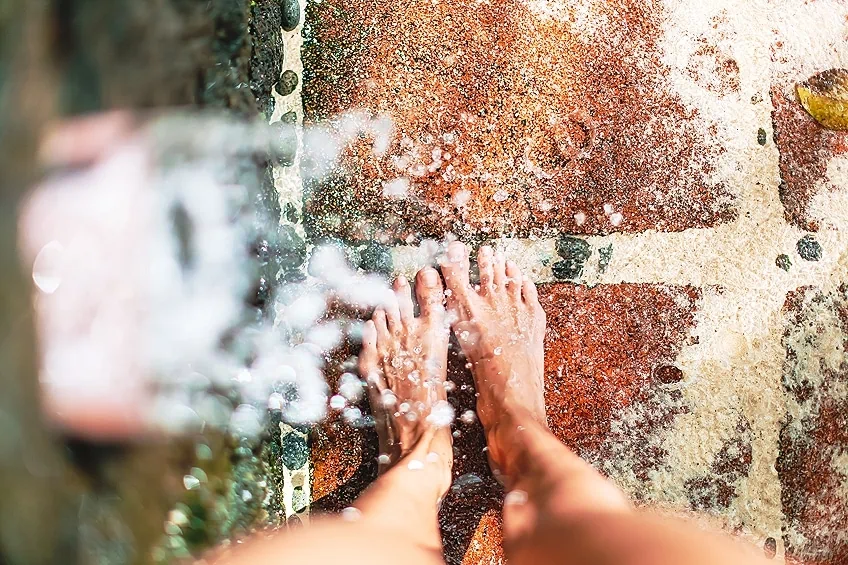
Next, seams and junctions around the drain are sealed to prevent leaks. In DIY projects, homeowners must be meticulous in this step, but a professional contractor will have the expertise to ensure the waterproofing is done correctly. Finally, the edges of the shower pan where it meets the walls are sealed with waterproof caulking, completing the defense against potential water damage.
How to Choose the Right Shower Pan Size
Selecting the correct shower pan size is crucial for a functional and aesthetically pleasing bathroom. This involves considering the layout, shower type, design preferences, budget, and any special accessibility needs.
Bathroom Layout
Measurements are critical when assessing the bathroom layout for a new shower pan. One must ensure there’s enough space for the shower itself while allowing for clearances as dictated by local building codes. Typically, a clearance of 30 inches in front of the shower is advisable.

Shower Type
The shower type dictates the shape and dimensions of the shower pan. For a basic shower, sizes such as 36″ x 36″ are common. For corner showers, options like 32″ x 32″ or 36″ x 36″ are suitable. Rectangular shower bases tend to measure on average 60″ x 30″.
Design Preferences
Design preferences can influence the choice of a shower pan, not only in size but also in style. Prefabricated shower pans are available in standard sizes from 32″ square inches to 60″ inches in length, and a range of depths.

Budget
Budget may limit or expand the options available. Standard-sized pans are typically more cost-effective than custom sizes. To ensure durability and prevent the need for early replacement, selecting a shower pan that fits the budget without compromising on quality is key.
Accessibility Needs
For those with accessibility needs, shower pan sizes should allow for easy entry and exit. The depth of the pan is also important, with shallower bases often preferable for those requiring assistance or using mobility devices. In addressing these factors, homeowners can confidently select a shower pan that suits their specific situation, contributes to the overall function and style of the bathroom, and provides a reliable foundation for their shower space.

Other Considerations
When selecting a shower pan, one must appraise more than mere dimensions. The drain position is vital for compatibility with existing plumbing fixtures. Variants include offset drain, center drain, and on-edge drain configurations. Curbless shower pans are an ideal choice for accessible design, allowing easier entry and exit. Conversely, water-barrier pans, often featuring raised edges, aim to prevent water leakage and promote safety. Material selection for shower pan sizes is crucial for both longevity and aesthetics. Options include acrylic, fiberglass, and tileable units, each with distinct benefits: Acrylic is lightweight, durable, and easy to clean.
Fiberglass is cost-effective and simple to install. Tileable units offer customizability but require professional installation. Choose wisely for a shower pan that suits your needs and style preferences.
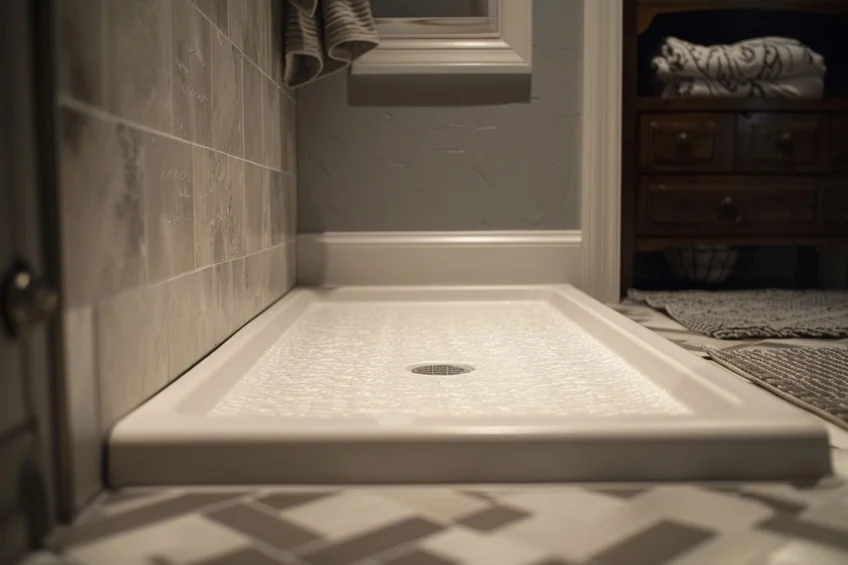
Temperature sustainability and slip resistance are also paramount. Materials should be evaluated for their grip and whether they can withstand hot and cold cycles without cracking. Check compliance with local building codes for installation and waterproofing. Only pans meeting these regulations should be installed. Finally, consider the shower pan’s role in aesthetics. It should complement the bathroom’s overall design, color, and style.
As we wrap up our exploration of shower pan sizes, it’s clear that the dimensions of your bathing space can truly make a splash in your daily routine. Whether you opt for compact convenience or luxurious expansiveness, the right shower pan size sets the stage for your bathroom oasis. Remember, it’s not just about fitting into the space; it’s about creating a space that fits you just right. So, as you embark on your design journey, may your showers be as perfectly proportioned as they are refreshing. Happy bathing!
Frequently Asked Questions
What Factors Determine the Dimensions of a Shower Pan?
The size of a shower pan is typically determined by the bathroom’s layout, the shower’s design, user preference, and the type of shower enclosure. For example, corner showers conserve space while rectangular bases are common for traditional setups.
What Are the Common Dimensions for Large Shower Pans?
Large shower pans generally start at 42 inches wide by 60 inches long. Depths can vary from 1 inch to 6 inches, accommodating different shower entry styles and user preferences.
What Is the Difference Between a Shower Tray and a Shower Base?
A shower tray refers to the prefabricated floor piece that sits below the shower enclosure, often including the edge or lip. A shower base often implies the structural floor under the shower tray, which can either be prefabricated or custom-built to fit the space.

